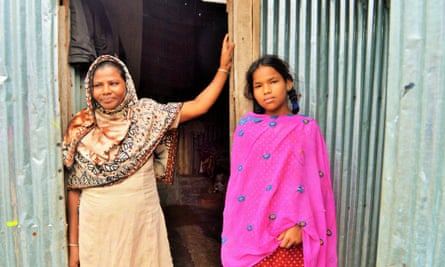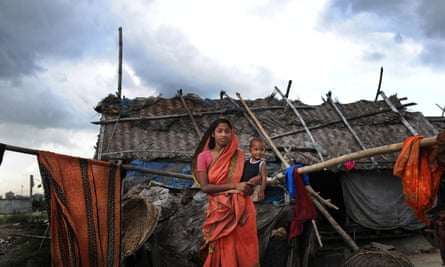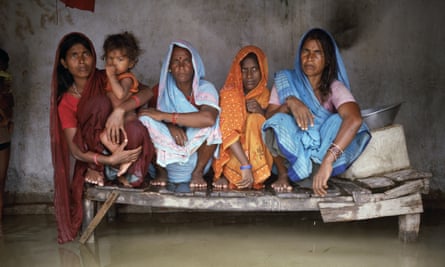Parul Akter travelled across Bangladesh to escape the flood waters, but they seem to have followed her. The shack she shares with her husband and four children in Dhaka, the nation’s capital, sits on the edge of the sprawling Korail slum – next to a lake. When it rains, dank water sloshes into their shelter. Only the bed, raised up on bricks, stays dry. “This room is all we have, so we need to stay here no matter what happens,” said Akter.
Seven years ago, a monsoon flood left nothing standing in their village, located in Bhola on the country’s south-west coast. “We had no option but to climb up the banks with our belongings immediately,” said Akter. “Within a week, we moved to Dhaka to start a new life.”
Every day, some 2,000 people settle in the Bangladeshi capital. It’s nothing new – for generations the city has been a magnet for men and women escaping rural poverty. But now there’s another driver that experts say has accelerated the race to the capital: the Earth’s changing climate, which has already made life extremely difficult in stretches of this pancake-flat country threaded with rivers. In the coming decades, millions more “climate refugees” around the world are expected to make similar journeys. In a cruel irony, many will wind up in cities even more ill-equipped to withstand the changing climate.

Bangladesh contributes just 0.4 metric tonnes per capita to the carbon emissions fuelling climate change (the US produces 17 and the UK 7.1), but will suffer its effects badly. Within three decades, the country is expected to be at least 2C hotter. By 2080, the seas could be 2ft higher.
The glaciers in the Himalayas will melt faster, sending more floodwaters to batter the Bay of Bengal. Cyclones will wrack the coast more frequently, and with more intensity. Salty seawater will pollute drinking supplies. Fertile land will be destroyed.
Some of this is already happening. There have not been many studies indisputably tying Bangladesh’s rural exodus to climate. But research indicates that the majority of migrants hail from coastal areas that are already experiencing rising sea levels, increased salinity, destructive floods and cyclones. At least 400,000 people move to Dhaka every year, according to the World Bank, while the International Organisation for Migration (IOM) estimates that 70% of Dhaka’s slum-dwellers moved there fleeing some sort of environmental shock.
In 2012, A S Moniruzzaman Khan, the director of the Centre for Climate Change and Environmental Research at BRAC University, tracked 1,500 families migrating to cities, mostly Dhaka.
Almost all cited the changing environment as the biggest reason for their decision. They were struggling to find fresh water to drink, as rising seas spilled into rivers.
“Ten years back, the area was freshwater – now it is not,” Khan said. He heard of women and children having to walk an extra five hours each day to find clean water. The task was considered too dangerous, so men went instead – taking a sizeable chunk out of the earnings of the family’s main breadwinner. “If you provide water, this migration issue would probably never come,” said Khan.

It’s not just Bangladesh. All over the world, people are or will be on the move – in Africa, largely due to drought; in Asia, floods. By 2060, there could be between 25 million and 1 billion environmental migrants. And cities will be their primary destination. Foresight, a UK government research body, says that by 2060 there will be 192 million more people living in vulnerable urban coastal floodplains, mainly in Asia.
“Those moving to water-stressed or low-lying coastal cities in developing countries may paradoxically find themselves exposed to greater climate-change related risks,” a 2014 report by IOM reads.
Part of the problem is population. Asia’s megacities show no signs of shrinking, even as rising sea levels render them more vulnerable to storm surges.
A 2011 study of the 20 most populous cities expected to be exposed to coastal flooding by 2070 placed Dhaka third, behind Mumbai and Calcutta. Also in the top 10 are Guangzhou, Ho Chi Min City, Shanghai, Bangkok and Yangon. Miami is the only city in a developed country to feature on the list.
But despite the challenges, solutions for environmental migrants rarely feature on urban development plans. Climate refugees still have no legal standing under international law. No binding global agreements contain provisions for them, despite the first assessment report by the Intergovernmental Panel on Climate Change in 1990 suggesting that “the gravest effects of climate change may be those on human migration”.
Specialists had hoped that the climate talks in Paris starting on 30 November would persuade countries to prioritise the issue. But environmental migration has reportedly been removed from the final agenda, though it could be reintroduced during negotiations.

‘Every city has a carrying capacity’
In Dhaka, meanwhile, a teeming megacity of more than 15 million people packed into a 325 sq km radius, the climate refugees are finding a city where everything is clogged – from roads and pavements to rivers and drains.
The slums, already home to hundreds of thousands, are expanding rapidly. Within two decades, the city’s population could double to 30 million.
“Every boat has a carrying capacity, every city has a carrying capacity,” said Sarder Shafiqul Alam, a senior researcher at the International Centre for Climate Change and Development and Bangladesh’s representative at the Rockefeller Foundation’s Asian Climate Change Resilience Network. “If that carrying capacity is over-burdened and over-burdened, what will happen? Boat will capsize. City will do something like that.”
People coming to Dhaka after environmental disasters face more problems, he said. “They’re not getting enough safe water to drink; they’re not getting sanitation facilities.”
In yet another irony, even though Dhaka is prone to flooding, it is also running dry. About 90% of the city’s water supplies come from ground reserves, which are depleted by three metres a year. There’s a supply-demand gap of 500m litres a day, according to a 2014 report, leading to chronic shortages and protests in the summer months.

Long-term groundwater depletion causes the earth to sink, which exacerbates flooding, a major problem in Dhaka. It can also lead to the intrusion of salty water into the supply – the same problem that contributes to rural-urban migration.
On the face of it, climate change is poised to be the latest disaster to cripple Bangladesh, a nation that has been beset by compounding crises since it was founded in 1971.
But Bangladeshis are accustomed to bouncing back. Or, as Khan puts it: “Our people like to face challenges.”
The country boasts the world’s largest non-profit, BRAC, and is the birthplace of micro-finance, thanks to Nobel Laureate Muhammad Yunus. Armies of field workers have responded to climate challenges with innovation. Farmers whose salt-washed land is unfit to grow regular rice have turned to salt-tolerant strains, or raised shrimp instead. And there has been a concerted effort to persuade villagers not to leave their homes.
Some people argue, however, that environmental migrants have a legal claim to be resettled on public land. S M Mahmudul Hasan, 55, a community leader at Korail, has an encyclopedic knowledge of the residents, mostly families who migrated from places such as Bhola and Barial.
“They have lost their houses in natural disasters and have had no income in the villages,” he said.
Most now eke out a living as street sweepers, rickshaw drivers and domestic workers in slums where they face the constant threat of eviction. They miss the countryside. “Life in the village was good,” said Helena Akter, whose home in Barisal was swallowed by the river. “We had land to cultivate and our family lived happy all year round. In Dhaka, we struggle for survival.” But, she adds, “It feels good to be in Dhaka. Although we are poor, we don’t need to be afraid of losing our house in the river any more.”

Comments (…)
Sign in or create your Guardian account to join the discussion